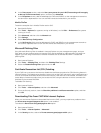
Interface Description
• View alerts and CMC IP.
• Set DHCP.
• Configure CMC static IP settings.
• View CMC MAC address for the active CMC.
• View the CMC VLAN ID appended to the end of CMC IP, if the VLAN
is already configured.
Telnet Provides command line access to CMC through the network. The
RACADM command line interface and the connect command, which is
used to connect to the serial console of a server or IO module, are
available from the CMC command line.
NOTE: Telnet is not a secure protocol and is disabled by default.
Telnet transmits all data, including passwords in plain text. When
transmitting sensitive information, use the SSH interface.
SSH Use SSH to run RACADM commands. It provides the same capabilities as
the Telnet console using an encrypted transport layer for higher
security. The SSH service is enabled by default on CMC and can be
disabled.
WS-MAN The WSMAN Services is based on the Web Services for Management
(WSMAN) protocol to perform one-to-many systems management
tasks. You must use WS-MAN client such as WinRM client (Windows) or
the OpenWSMAN client (Linux) to use the LC-Remote Services
functionality. You can also use Power Shell and Python script the WS-
MAN interface.
WSMAN is a Simple Object Access Protocol (SOAP)–based protocol
used for systems management. CMC uses WS–Management to convey
Distributed Management Task Force (DMTF) Common Information
Model (CIM)–based management information. The CIM information
defines the semantics and information types that can be modified in a
managed system.
The CMC WS-MAN implementation uses SSL on port 443 for transport
security, and supports basic authentication. The data available through
WS-Management is provided by CMC instrumentation interface mapped
to the DMTF profiles and extension profiles.
For more information, see:
• MOFs and Profiles — delltechcenter.com/page/DCIM.Library
• DTMF Web site — dmtf.org/standards/profiles/
• WS-MAN Release notes file.
• www.wbemsolutions.com/ws_management.html
• DMTF WS-Management Specifications: www.dmtf.org/standards/
wbem/wsman
Web services interfaces can be utilized by leveraging client
infrastructure, such as Windows WinRM and Powershell CLI, open
source utilities like WSMANCLI, and application programming
environments like Microsoft .NET.
37


















